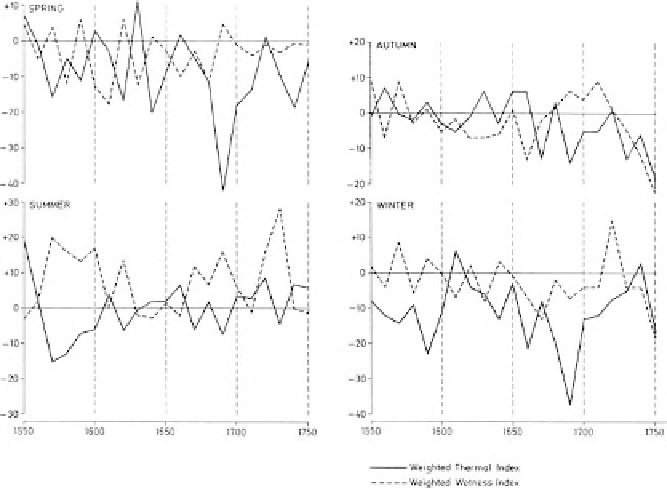Geoscience Reference
In-Depth Information
Figure 8.5 Weighted
thermal and wetness indices
for Switzerland for the
seventeenth century.
(Adapted from Grove
1988
)
the last quarter of the century were the coldest in 500 years. These seasons were
usually very dry. Summers often had cool, wet conditions, although occasionally
extremely hot and dry weather (and drought) occurred. In England, severe winters
occurred in 1600-9, the 1680s, and the 1690s. Fagan (
2000
) reports that the winter
of 1683-4 was so severe that sea ice occurred along the coasts of the English
Channel, and the ground froze to depths exceeding one meter. In Switzerland, the
1620s and 1640s were very cold (Figure
8.5
), with glacial advances in the Alps.
Particularly in the last quarter of the century, temperatures in most of Europe
averaged 1.5 to 2.0 8C lower than the mid twentieth century.
Significant periods of severe convection creating stormy weather were also a
major feature, leading to periods of high flood frequency in central Europe and
along the coast. Precipitation frequency was greater in summer and lower in
winter compared to present conditions. Comparisons of precipitation indices
between 1675 and 1704 for England and Switzerland byWanner et al.(
1995
) are
representative of most of Europe, and establish that regional variations occurred:
In winter, precipitation in England was average or slightly lower than normal up to 1692,
and higher than average thereafter. According to Grove (
1988
), in the 1690s there were
more snow days in London than ever recorded before or since. In Switzerland precipita-
tion was considerably lower than average for the entire period except for 1682-4.
Spring rain or snowfall in England was much higher than average except between 1696
and 1700. Spring was delayed in Scotland, and higher than normal snowfall, supported
by enhanced lapse rates and instability, lasted into the early summer. Switzerland in
spring was drier up until 1691, and wetter in most years until 1700.

Search WWH ::

Custom Search